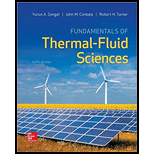
Concept explainers
a)
The change in entropy of helium.
a)
Explanation of Solution
Given:
The volume of the helium gas
The initial pressure of the helium gas
The initial temperature of the helium gas
The final pressure of the helium gas
The initial temperature of the helium gas
The surrounding temperature
Calculation:
Refer Table A-1E, “the molar mass, gas constant and critical–point properties table”,
The gas constant of helium
Calculate the mass of helium
Refer Table A-2E, “Ideal-gas specific heats of various common gases”,
The specific heat at constant pressure
The specific heat at constant volume
Calculate the change in entropy of helium.
Thus, the change in entropy of helium is
b)
The entropy change of the surrounding.
b)
Explanation of Solution
Calculate the final volume of the helium
Write the expression for the polytropic process.
Rewrite the above Equation to obtain the exponent n.
Calculate the boundary work for the polytropic process
Write the expression for the energy balance equation of the system.
Here, net energy transfer inside the system is
Substitute
Calculate the entropy change of the surrounding.
Thus, the entropy change of the surrounding is
c)
Whether this process is reversible, irreversible, or impossible.
c)
Explanation of Solution
Calculate the total entropy change during the process.
Thus, the total entropy change during the process is
The value of the total change in entropy
Want to see more full solutions like this?
Chapter 8 Solutions
Fundamentals of Thermal-Fluid Sciences
- 180- Dimensions in mm 100 100 D E Steel B Brass 60 kN 40 kN 40-mm diam. 30-mm diam. PROBLEM 2.40 Solve Prob. 2.39, assuming that rod AC is made of brass and rod CE is made of steel. PROBLEM 2.39 Two cylindrical rods, one of steel and the other of brass, are joined at C and restrained by rigid supports at A and E. For the loading shown and knowing that E = 200 GPa and E, 105 GPa, determine (a) the reactions at A and E, (b) the deflection of point C. = R = 45.5 kN ← Aarrow_forwardDimensions in mm 100 100 -180- -120-+- C D Steel B Brass 60 kN 40 kN 40-mm diam. 30-mm diam. E PROBLEM 2.39 Two cylindrical rods, one of steel and the other of brass, are joined at Cand restrained by rigid supports at A and E. For the loading shown and knowing that E = 200 GPa and E₁ = 105 GPa, determine (a) the reactions at A and E, (b) the deflection of point C.arrow_forward(read image) (Answer: vE = 0.514 m/s)arrow_forward
- 0.36 m Problem 2.27 P=5kN D Each of the links AB and CD is made of aluminum (E=75 GPa) and has a cross-sectional area of 125 mm². Knowing that they support the rigid member BC, determine the deflection of point E. B E 0.44 m 0.20 marrow_forward(read image) (Answer Given)arrow_forward(read image) Answer: A = 1192 Narrow_forward
- The correct answer is ~168 MPa, how was this found?arrow_forwardAir enters the compressor of a regenerative gas turbine engine at 310 K and 100 kPa, where it is compressed to 900 kPa and 650 K. The regenerator has an effectiveness of 75%, and the air enters the turbine at 1400 K. Assume variable specific heats for air. For a turbine efficiency of 90 percent, determine the amount of heat transfer in the regenerator. The amount of heat transfer in the regenerator is kJ/kg.arrow_forwardAir enters the compressor of a regenerative gas turbine engine at 310 K and 100 kPa, where it is compressed to 900 kPa and 650 K. The regenerator has an effectiveness of 79 percent, and the air enters the turbine at 1400 K. Assume constant specific heats for air at room temperature. The properties of air at room temperature are cp = 1.005 kJ/kg·K and k = 1.4. For a turbine efficiency of 90 percent, determine the amount of heat transfer in the regenerator. The amount of heat transfer in the regenerator is kJ/kg.arrow_forward
 Elements Of ElectromagneticsMechanical EngineeringISBN:9780190698614Author:Sadiku, Matthew N. O.Publisher:Oxford University Press
Elements Of ElectromagneticsMechanical EngineeringISBN:9780190698614Author:Sadiku, Matthew N. O.Publisher:Oxford University Press Mechanics of Materials (10th Edition)Mechanical EngineeringISBN:9780134319650Author:Russell C. HibbelerPublisher:PEARSON
Mechanics of Materials (10th Edition)Mechanical EngineeringISBN:9780134319650Author:Russell C. HibbelerPublisher:PEARSON Thermodynamics: An Engineering ApproachMechanical EngineeringISBN:9781259822674Author:Yunus A. Cengel Dr., Michael A. BolesPublisher:McGraw-Hill Education
Thermodynamics: An Engineering ApproachMechanical EngineeringISBN:9781259822674Author:Yunus A. Cengel Dr., Michael A. BolesPublisher:McGraw-Hill Education Control Systems EngineeringMechanical EngineeringISBN:9781118170519Author:Norman S. NisePublisher:WILEY
Control Systems EngineeringMechanical EngineeringISBN:9781118170519Author:Norman S. NisePublisher:WILEY Mechanics of Materials (MindTap Course List)Mechanical EngineeringISBN:9781337093347Author:Barry J. Goodno, James M. GerePublisher:Cengage Learning
Mechanics of Materials (MindTap Course List)Mechanical EngineeringISBN:9781337093347Author:Barry J. Goodno, James M. GerePublisher:Cengage Learning Engineering Mechanics: StaticsMechanical EngineeringISBN:9781118807330Author:James L. Meriam, L. G. Kraige, J. N. BoltonPublisher:WILEY
Engineering Mechanics: StaticsMechanical EngineeringISBN:9781118807330Author:James L. Meriam, L. G. Kraige, J. N. BoltonPublisher:WILEY





